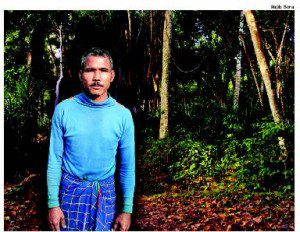http://wakeup-world.com/2012/05/10/lone-indian-man-plants-1360-acre-forest/

A little over 30 years ago, a teenager named Jadav “Molai” Payeng began burying seeds along a barren sandbar near his birthplace in northern India’s Assam region to grow a refuge for wildlife. Not long after, he decided to dedicate his life to this endeavor, so he moved to the site where he could work full-time creating a lush new forest ecosystem. Incredibly, the spot today hosts a sprawling 1,360 acre of jungle that Payeng planted single-handedly.
The Times of India recently caught up with Payeng in his remote forest lodge to learn more about how he came to leave such an indelible mark on the landscape:
It all started way back in 1979 when floods washed a large number of snakes ashore on the sandbar. One day, after the waters had receded, Payeng , only 16 then, found the place dotted with the dead reptiles. That was the turning point of his life.
“The snakes died in the heat, without any tree cover. I sat down and wept over their lifeless forms. It was carnage. I alerted the forest department and asked them if they could grow trees there. They said nothing would grow there. Instead, they asked me to try growing bamboo. It was painful, but I did it. There was nobody to help me. Nobody was interested,” says Payeng, now 47.
While it’s taken years for Payeng’s remarkable dedication to planting to receive some well-deserved recognition internationally, it didn’t take long for wildlife in the region to benefit from the manufactured forest. Demonstrating a keen understanding of ecological balance, Payeng even transplanted ants to his burgeoning ecosystem to bolster its natural harmony. Soon the shadeless sandbar was transformed into a self-functioning environment where a menagerie of creatures could dwell. The forest, called the Molai woods, now serves as a safe haven for numerous birds, deers, rhinos, tigers, and elephants — species increasingly at risk from habitat loss elsewhere.
Despite the conspicuousness of Payeng’s project, Forestry officials in the region first learned of this new forest in 2008 — and since then they’ve come to recognize his efforts as truly remarkable, but perhaps not enough.
“We’re amazed at Payeng,” says Assistant Conservator of Forests, Gunin Saikia. “He has been at it for 30 years. Had he been in any other country, he would have been made a hero.”
Video: Forrest Man
Source – treehugger.com
About the Author
Stephen Messenger is a freelance writer and linguist based in Porto Alegre, Brazil. He covers issues related to the environmental movement in South America, as well as to the political and social challenges of sustainable development in the region and throughout the world. Stephen’s work has appeared in numerous publications both on-line and in print, including the Wall Street Journal, Yahoo!, and the Huffington Post.
Disclaimer: We at Prepare for Change (PFC) bring you information that is not offered by the mainstream news, and therefore may seem controversial. The opinions, views, statements, and/or information we present are not necessarily promoted, endorsed, espoused, or agreed to by Prepare for Change, its leadership Council, members, those who work with PFC, or those who read its content. However, they are hopefully provocative. Please use discernment! Use logical thinking, your own intuition and your own connection with Source, Spirit and Natural Laws to help you determine what is true and what is not. By sharing information and seeding dialogue, it is our goal to raise consciousness and awareness of higher truths to free us from enslavement of the matrix in this material realm.
 EN
EN


























